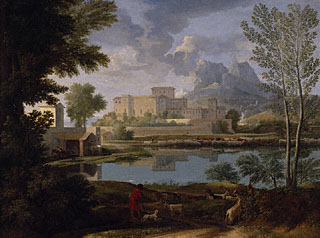• What do you see in the
foreground,
middle ground, and
background of the painting? (The trees, shepherd, and goats are all in the foreground. The middle ground holds the lake,
a few small buildings [stables] on the right of the painting, and the livestock. The palace is actually pushed further into
the background from the objects in the middle ground. It is much smaller in relative size to the small buildings and
livestock in the middle ground. Other objects in the background include the mountain and sky.)
• Where would you be if you walked into the painting? How does Poussin lead you through the painting?
(Poussin used line to lead us down the path in the foreground to the lake. The line of the lake then leads
the eye back around to the palace and to the mountain and sky. He also used color value [atmospheric perspective]
to show receding space, from darker colors in the foreground to lighter colors in the background.)
• Based on the mood of the painting, what title would you give this picture? Why?
• Some art historians have said that the theme of this work is man's relationship to nature.
If that is true, what do you think Poussin wanted to communicate about man's relationship to the natural world?
• Pay careful attention to the reflections in the water in this picture. What has the artist excluded from the reflections?
How does this exclusion affect the mood of the painting? (Poussin left out the reflections of the clouds in the water.
He chose to leave them out to make the work evoke a calm mood, rather than the turbulent mood that the cloud forms
might have created in the water's smooth surface.) |
In the late 1640s and early 1650s, Nicolas Poussin, at the height of his artistic maturity, turned from historical narrative to landscape painting. Landscape with a Calm does not illustrate a story but rather evokes a mood. The ordered composition and clear light contribute to Landscape with a Calm's serene tranquility, while glowing colors and fluid paint strokes enliven this scene of benevolent nature. Poussin's sketching campaigns in the Roman countryside with his friend and fellow landscape painter Claude Lorrain account, in part, for the fresh observation of cloud-scattered sky and grazing goats.
Poussin painted a pendant to this painting called Landscape with a Storm that is now in a museum in Rouen, France. Together, their contrasting weather effects embody nature's changing and unpredictable relationship with man. Poussin painted these works for the Parisian merchant Jean Pointel, a friend and great collector of his landscape paintings.
About the Artist
Pointing to his forehead, the Italian artist Gian Lorenzo Bernini called Nicolas Poussin "a painter who works up here," referring to his carefully planned compositions. Poussin was the chief formulator of the French classical tradition in painting. By the mid-1630s, he began exploring a serene, classical style inspired by the colors of Titian and the simplified, sculptural quality of Raphael. He eliminated unnecessary detail and emphasized compositional balance and the other qualities of Classical art he admired in antiquities. His late works are essays in solid geometry, with movement minimized
and every element given a symbolic meaning and pictorial function.
Poussin's art developed slowly. His first major commission, an altarpiece for Saint Peter's Basilica in Rome, was unsuccessful; he never painted again for a public building in Rome but instead concentrated on small pictures for collectors. In 1640 Louis XIII, king of France, persuaded him to supervise a large decorative project in Paris, but Poussin soon returned to Rome, suited neither for large projects nor for court intrigue and competition. He usually painted what he chose, on speculation rather than commission, a practice that led to reputation, not riches. Despite weak, shaky hands, which plagued him as
early as 1643, Poussin painted by himself, lacking the resources required to run a large workshop with assistants and apprentices. His pictures, rather than pupils, shaped European art for generations. |
